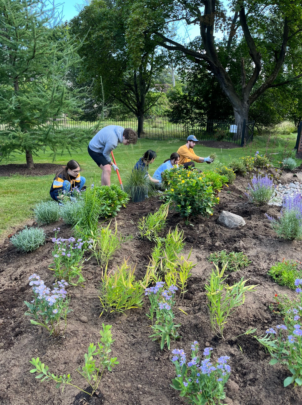The rain garden installed at the Witmer House, the current home of President Sarah Mangelsdorf and Professor Karl Rosengren, has received an upgrade. The garden update, situated in the back of the Witmer House, brought together University leadership, the Horticulture and Grounds department, and environmental science students for a chance to apply classroom learning to a real-world problem with water runoff.
A rain garden is a depression in the ground that collect stormwater and other sources of runoff. These gardens feature a variety of plants designed to reduce runoff and promote natural water filtration. A benefit of rain gardens is that you can expand them as needed to address runoff, a big reason why President Mangelsdorf and Professor Rosengren thought it was time for an update. “The expansion was necessary as part of increased water flow from a newly constructed patio and pavilion,” Rosengren explains. “We considered adding a second rain garden but felt there wasn’t a good location that would not put some of the historic trees on the property at risk.”
Historic trees, native plants, and sustainability construction seems to be Brandon Guerrero’s forte concerning the rain garden expansion project. As part of the Horticulture and Grounds department, Guerrero took the lead on this project and integrated his passion for sustainable initiatives. Not only are most of the garden’s plants native to the area, Guerrero also used recycled materials and varieties of rocks and wood chips from the Witmer House property in the expansion. In fact, according to Rosengren and per date markings, Guerrero found pottery and other artifacts from as far back as 1873. Guerrero has been involved in many projects on the property, including collaborating with the Seneca Park Zoo to plant a pollinator garden by the property’s entrance as well as building a trail leading from the president’s house to the provost’s house. Guerrero, along with President Mangelsdorf and Professor Rosengren, are eager for the University community to see what’s been growing on the property.
 Students also played a big part in the rain garden update. Similar to the original installation, students from Professor Karen Berger’s hydrology course EESC 213 joined in on planning and planting. The Horticulture and Grounds team briefed student volunteers about the procedures, took them on a tour of the seventeen-acre property, and led the group for a rewarding day earth scaping and planting. This proved to be an educational experience that extended beyond the classroom. “Before EESC 213 I didn’t really know what a rain garden was,” says Nuo Chen ‘24, a hydrology student who volunteered at the installation. Odessa Amaryllis ’24 knows about rain gardens and was interested in how the class would connect to the area. Since taking EESC 213, Amaryllis has spotted and explored rain gardens all over Rochester.
Students also played a big part in the rain garden update. Similar to the original installation, students from Professor Karen Berger’s hydrology course EESC 213 joined in on planning and planting. The Horticulture and Grounds team briefed student volunteers about the procedures, took them on a tour of the seventeen-acre property, and led the group for a rewarding day earth scaping and planting. This proved to be an educational experience that extended beyond the classroom. “Before EESC 213 I didn’t really know what a rain garden was,” says Nuo Chen ‘24, a hydrology student who volunteered at the installation. Odessa Amaryllis ’24 knows about rain gardens and was interested in how the class would connect to the area. Since taking EESC 213, Amaryllis has spotted and explored rain gardens all over Rochester.
When students, staff, and administrators come together with a focus on sustainability, good things grow. “My own view is that wherever possible we should be working on improving energy efficiency, reducing pollution, and being good stewards of our water systems,” Rosengren adds. The Witmer House residents are looking forward to new projects on the property and beyond, starting with the rain garden. For more information about sustainability initiatives on the Witmer House property, contact Brandon Guerrero at bguerrer@facilities.rochester.edu.
Written by Carmen Marshall ‘25
Photos by Carmen Marshall and John McIntyre / University of Rochester

